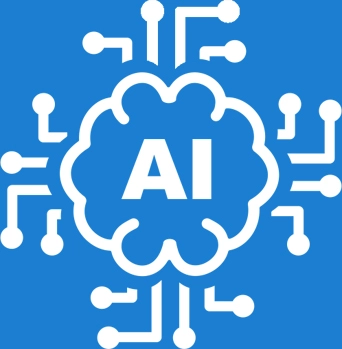


Artificial Intelligence, in short AI, is now a fast-growing technology and one of the fascinating and universal fields of the computer science environment and has the greatest scope in the future. We are living in an era where everything in one way or another is related to AI. Nowadays, can you think about a day without your Smartphone? Literally for each and everything we need this simple handset. When AI was incorporated with this simple handset it became a multifunctional system and from ‘phone’ it became ‘Smartphone’. So, what is AI?

In this world, we all are surrounded by machines and smart devices, many of them working based on the AI principle.
Let us think of a self-driving car, the car itself is making decisions without the help of a driver from the data it receives from the various sensors like the human brain. How is that possible? The answer is AI.
Let us take another example as a chess game. Have you ever thought about how the computer or your smartphone is playing perfectly like a human opponent? Again, the answer is AI or Artificial Intelligence.
Let’s try to understand the meaning of the term artificial intelligence by splitting the term into two: Artificial + Intelligence. The term ‘Artificial’ refers to something produced by human beings rather than occurring naturally, more specifically a copy of something natural. The word ‘Intelligence’ refers to the ability to acquire and apply knowledge and skills. So, in short, Artificial Intelligence is an artificially created Intelligence.
The incredible power of humans to use their brain (intelligence) makes them distinguishable from other creatures. Learning, Reasoning, and Problem Solving are the key factors of human intelligence. Human Intelligence is the mental quality to think rationally, act purposefully, and deal effectively with one’s environment. When this human Intelligence integrates on machines to mimic human behavior, a new technology emerges and is named Artificial Intelligence.If a machine is using AI, there is no need for pre-programming or re-programming for different situations like a normal machine. AI machines can understand and make decisions for situations or conditions that never happened before.
How can we define intelligence, so difficult right? Same in the case of AI, AI is not just one technology, it is a set of technologies working together to make a machine to sense, grasp, act and learn and make decisions with intelligence. Hence it is difficult to define AI in one way and so AI holds a different set of definitions. Let’s have a look at how different people define AI:
John McCarthy, one of the men who positioned as the father of AI coined the term ARTIFICIAL INTELLIGENCE in the 1950s. He said “Every aspect of learning or any other feature of intelligence can in principle be so precisely described that a machine can be made to simulate it. An attempt will be made to find how to make machines use language, form abstractions, and concepts, solve the kinds of problems now reserved for humans, and improve themselves.”
The English Oxford Living Dictionary gives this definition:
“The theory and development of computer systems able to perform tasks normally requiring human intelligence, such as visual perception, speech recognition, decision-making, and translation between languages”.
Another definition for AI is: “Artificial Intelligence is the stimulation of human Intelligence on man-made machines that are well programmed with a set of algorithms which can work with their own Intelligence and act like a human”
Before going to a deep study about artificial intelligence we must have knowledge about why this new technology is needed? What can AI offer to our world? and much more. Let us discuss some of the uses of AI in the modern world.
We have already discussed that AI is not a single technology, in General, we can explain the working of AI as a machine that is able to receive a huge amount of data from different devices and it processes and learns from that data using different intelligent algorithms and making decisions dynamically.
AI makes the machine make decisions using a large number of components of technologies which we can call subdomains. To understand How Artificial Intelligence actually works, you need to get to know about the subdomains of AI and understand how those domains are applied.
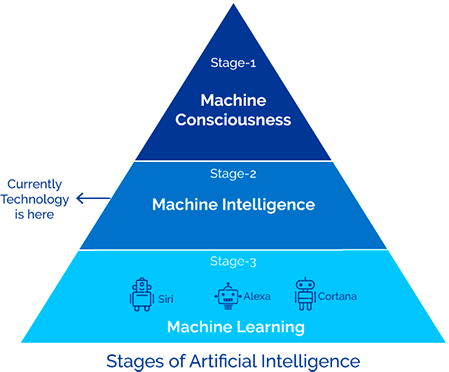
Now we know about AI and the need for AI and how AI works. Now let us check the lifecycle of AI. What are the different stages of Artificial intelligence?
STAGE 1: - Machine learning
Set of algorithms used to teach a machine to make inferences and decisions from past experience
STAGE 2: - Machine intelligence
The advanced round of algorithms is used by machines to learn from experience. Deep Neural Networks is an example. Currently, Artificial Intelligence technology is at this stage.
STAGE 3: - Machine consciousness
Machines learn themselves from experience without the need for external data.
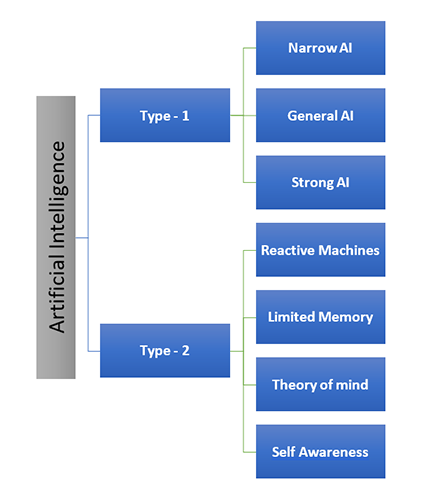
We mentioned above that AI has a wide range of applications and functionalities in the modern world. There are a lot of areas where these AI applications are used, that starts from a simple game to even in military operations. So generally Artificial intelligence can be broadly divided into two types based on the capability of an AI machine and the functionalities that an AI machine can do.
Based on capabilities AI is classified into three:
Based on functionalities artificial intelligence is classified into four:
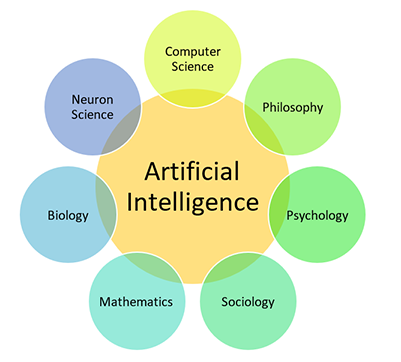
Artificial Intelligence is not just computer programming, it is not just a technology. We already stated that AI is making a machine to analyze and learn from the data and make decisions from the learned data. Let us think of the intelligence of a human, we know intelligence is a combination of Reasoning, Learning, Problem Solving, Perception, Linguistic Intelligence, etc. like the same way artificial intelligence comprises a lot of computer and mathematical aspects. To achieve the above factors for a machine AI requires the assistance of
Now we know about artificial intelligence and it's time to discuss what we aim in using artificial intelligence or what are achievements we are going to make using artificial intelligence.
|
1943 |
The first artificial neuron ‘The Threshold Logic Unit (TLU), or Linear Threshold Unit’ was proposed by Warren McCulloh, a neurophysiologist, and Walter Pitts a Mathematician. The model was specifically targeted as a computational model of the “nerve net” in the brain. |
|
1949 |
Donald Hebb a psychologist introduced the neuro-scientific concept of Hebbian learning also known as Hebb’s Rule or Cell Assembly Theory, which in turn attempts to connect the psychological and neurological underpinnings of learning. |
|
1950 |
An imagination game (Turing Test) by Alan Turing, a mathematician, was proposed to test a machine’s ability to exhibit intelligent behavior equivalent to that of a human. |
|
1955 |
The first Artificial Intelligence program deliberately engineered to perform automated reasoning called Logic Theorist was written by Allen Newell, a researcher in computer science and cognitive psychology, Herbert A. Simon, an economist, political scientist, and cognitive psychologist, and Cliff Shaw, a system programmer. Logic Theorist proved 38 of the first 52 theorems in chapter 2 of Rusell’s Principia Mathematica. One of the proofs was actually more elegant than the proof produced by hand by Rusell |
|
1956 |
John McCarthy, a computer Scientist organized the Dartmouth Conference, at which the term ‘Artificial Intelligence’ was first adopted. |
|
1956-1959 |
High-level computer languages such as FORTRAN, LISP, or COBOL were invented. |
|
1966 |
The first chatbot (AI software that can simulate a conversation with a user in natural language) named ELIZA was created by Joseph Weizenbaum. |
|
1971 |
The first expert system, DENDRAL, was introduced by Edward Feigenbaum, a computer scientist. |
|
1972 |
The first anthropomorphic robot called WABOT was developed in the world. |
|
1974- 1980 |
The duration between the years 1974-1980 was known as the first AI winter. During this period of time, the public interest in AI appears to wane, funding for activities geared toward developing AI in machines is lacking.
|
|
1980 |
The first National Conference on Artificial Intelligence was held at Stanford California. |
|
1987-1993 |
The duration between the years 1987-1993 was the second AI winter. Again lack of funding became a big problem due to high cost. The expert system such as XCON was very cost-effective. |
|
1997 |
An IBM computer called IBM Deep Blue beat the world chess champion after a six-game match |
|
2002 |
iRobot launches the Roomba which navigates the floor area of a home and cleans it. |
|
2006 |
The Dartmouth Artificial Intelligence Conference for the Next 50 Years (AI@50) took place. |
|
2009 |
Google builds autonomous cars. |
|
2010 |
Microsoft launched Kinetic for Xbox 360, the first gaming device to track human body movement. |
|
2011-2014 |
Apple’s Siri, Google’s Google Now, Microsoft’s Cortana. |
|
2015 |
Google Deepmind’s AlphaGo defeated 3-time European Go champion 2 dan professional Fan Hui by 5 games to 0. |
|
2018 |
An AI program “Duplex” was demonstrated by Google which was a virtual assistant. |
|
2020 |
Meeting Owl, Kuri Mobile Robot, etc. |
Following are some of the main advantages of artificial intelligence
Being so advantageous, AI still has some disadvantages which must be kept in our mind while creating an AI system. Following are some of them:
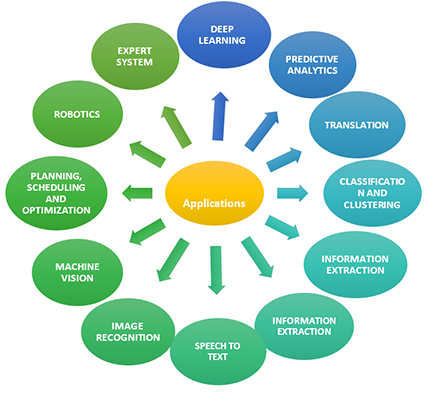
Nowadays there are a lot of areas we are using AI which can be categorized according to the use and functionality of the AI. See the below table to understand the categories and their applications where AI is used at the Application level.
|
Area |
Applications |
|
DEEP LEARNING APPLICATION
|
Fraud Detection. Autonomous Cars. Virtual Assistants. Supercomputing. Customer Relationship Management (CRM) Systems. Investment Modeling. Facial Recognition Systems. |
|
PREDICTIVE ANALYTICS
|
Google Flu Trends (GFT) Bing Amazon Netflix Coursera edX Udemy |
|
TRANSLATION
|
Lingua Custodia SYSTRAN SDL Government Canopy Innovations Text grabber The ili Pilot Google Translate Skype |
|
CLASSIFICATION AND CLUSTERING
|
Fantasy Football and Sports Document Analysis Identifying Fraudulent or Criminal Activity Classifying Network traffic Marketing and Sales Spam Filter Identifying Fake News |
|
INFORMATION EXTRACTION
|
Business Intelligent Financial Investigation Scientific Research Media Monitoring Health Care Record Management Pharma Research |
|
SPEECH TO TEXT
|
Dragon Anywhere Google Assistant Transcribe-Speech to Text Speech Notes- Speech to Text Voice Notes Braina Speech Texter- Speech to Text |
|
TEXT TO SPEECH
|
Speech Central Voice Dream Reader Motoread Voice Aloud Reader The Verdict Murf Notevibes |
|
IMAGE RECOGNITION
|
Google Lens Flow TapTapSee Leaf Snap Calorie Mama Vivino Screenshop |
|
MACHINE VISION |
Electronic component analysis Signature identification Optical character recognition Handwriting recognition Object recognition Pattern recognition Materials inspection Currency inspection Medical image analysis |
|
PLANNING, SCHEDULING AND OPTIMIZATION
|
Top-K Planners Semi-Black box for transportation Planner 4J DOCIT Plan recognition as Planning Google Calendar Calendar Hero |
|
ROBOTICS
|
Starship Delivery robots Pepper Humanoid Robot Penny Restaurant Robot Nimbo Security Robot Shadow Dexterous Hand Moley Robotic Kitchen system Flippy Robotic Kitchen Assistant |
|
EXPERT SYSTEM
|
MYCIN DENDRAL PXDES CaDet |